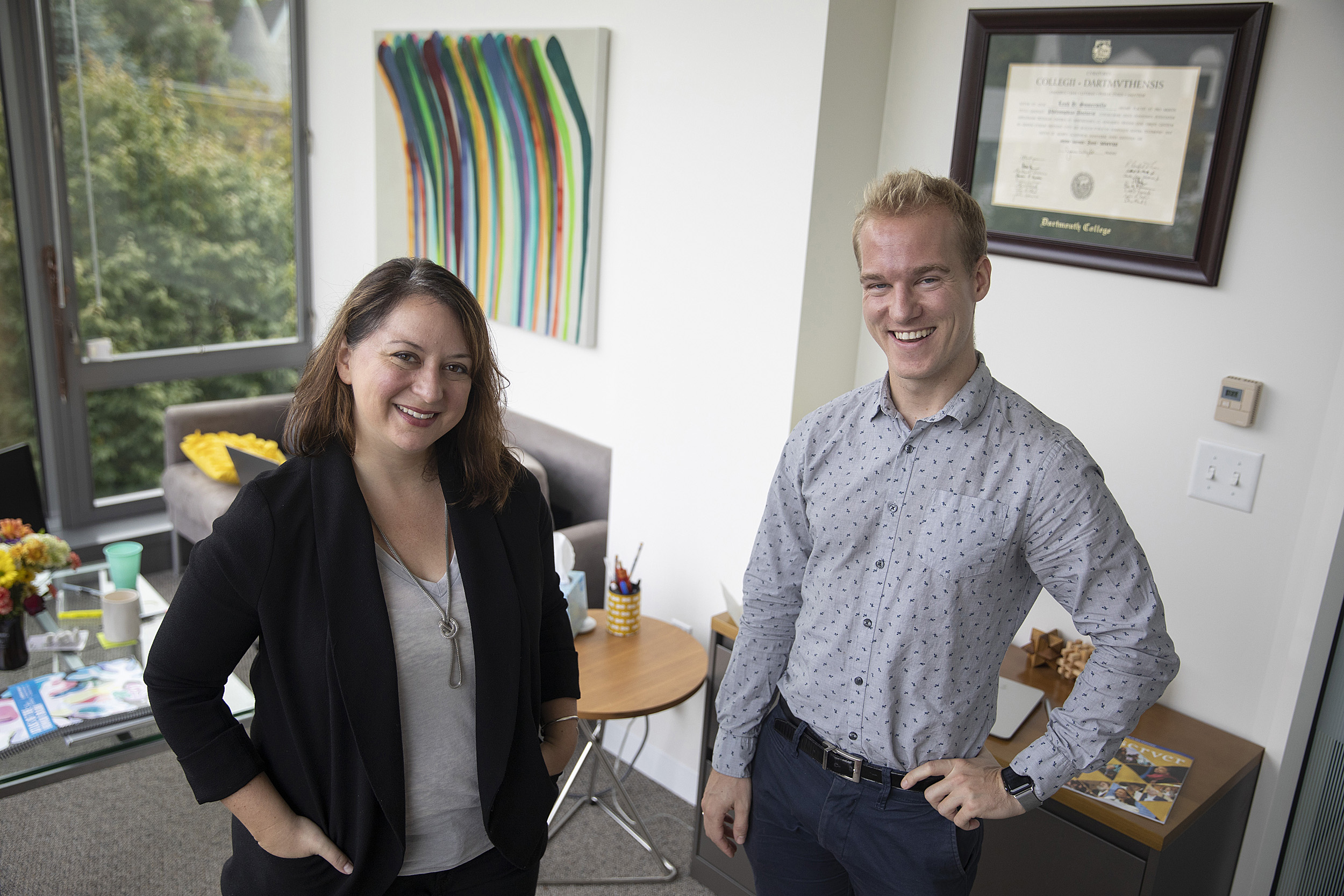
Leah Somerville is the senior author on a recent paper that shows that teens have a harder time differentiating their emotions.
Kris Snibbe/Harvard Staff Photographer
For teens who feel it all, a research-backed explanation
Study examines evolution of emotion differentiation
When teenagers seem to be experiencing conflicting emotions at the same time and struggling to make sense of them all, it may be because they are.
That’s the finding of a new study by Leah Somerville and Erik Nook, a Ph.D. student working in her lab. Other co-authors were Katie McLaughlin, now an assistant professor of psychology; Psychology Department researcher Stephanie Sasse; and Hilary Lambert of the University of Washington. The research was described in a paper in Psychological Science.
“In particular, what we wanted to look at is how people can take the messy mix of feelings we have at any moment and try to make sense of them by giving them specific labels … and how that process changes,” Nook said. “Because some people are very specific in making sense of what they’re feeling, whereas other people might just say they feel bad, but can’t be more specific than that.” This ability to specifically identify one’s emotions is called emotion differentiation or emotion granularity.
“It’s very common to co-experience multiple emotions,” Somerville added. “But what Erik was able to do was to … chart out how that process of differentiating our emotional states changes from childhood to adulthood.”

The study tested two competing ideas. The first was that people would slowly and steadily show more emotion differentiation as they got older, and the second was that the ability to parse emotions would fall along a U-shape, in which differentiation would be high in childhood and adulthood but low during adolescence.
A close examination of the data, Somerville said, showed that younger children scored higher on emotional differentiation because they tended to pick one emotion — and only one — when asked about their feelings.
“Basically, they’re just putting all their cards in one pile,” Somerville said. “And what we think is going on is that young people hold the belief that it’s only reasonable to experience one emotion at a time, and with increasing age they let go of that belief.
“That would result in a middle period — adolescence — where they don’t have that belief any longer, and they’re co-experiencing lots of emotions without a great amount of experience to parse them apart,” she continued.
To test the ability of people at different ages to differentiate their emotions, Nook designed an experiment in which participants ranging in age from 5 to 25 viewed images specifically selected to induce five different emotions — anger, disgust, fright, sadness, and upset. (Parents of the children who took part in the study were given a chance to view the images in advance.)
“Decades of work have gone into developing a set of images which we know will induce feelings in people and which we have good standard ratings on,” he said. “We showed participants 20 pictures that we know tend to make people feel negative emotions … and we asked how much each image made them feel the five different emotions.”
Participants studied each image for six seconds. After viewing the image, they were presented with a set of sliding bars with which to indicate how much they felt each emotion, from not at all to extremely.


Examples of the images used in the study to elicit emotional responses from participants.
Courtesy of Leah Somerville

“After they looked at all 20 images, we used a statistic that is basically a souped-up correlation to understand whether they were responding in the same kind of way to each image … or if they have a different set of emotional ratings for each image.”
The data, Nook said, showed that from childhood to adolescence, the ability to differentiate emotions decreased, reaching its nadir at around 15 before increasing into adulthood.
While the finding fits with the stereotypical image of adolescents struggling to deal with shifting emotions, there are specific and serious reasons for seeking to understand how and why teens might struggle to make sense of their feelings.
Adolescence repeatedly has been shown as the most common age for the onset of mental illness, Nook said, and studies repeatedly have found links between mental illness and lack of emotion differentiation.
“There are many findings that correlate high emotional differentiation with indices of mental health and well-being,” he said. “There are a slew of studies showing that people with depression, social anxiety, autism, schizophrenia, the list goes on — all of these disorders are characterized as having low emotional differentiation, and unfortunately, there isn’t a really great explanation for why.”
Links between mental illness and emotion differentiation would be a natural area for additional study, Somerville said.
More like this
“We can’t link our data, necessarily, to mental illness,” she said. “However, the natural way that development plays out is creating, I think, a period of low differentiation for adolescents, which could have some important implications for their health and well-being.”
More generally, Somerville is investigating how abstract conceptions of emotions change as we age, with an eye on developing an understanding of emotional development that could be used as a benchmark for measuring risk of mental illness.
“As we had said, adolescence is a period that is very healthy in many, many ways, but the onset of mental illness is one key risk factor,” she said. “We’re interested in these processes because if we can understand what a normal trajectory looks like … then clinical scientists can use this to try to think about the unique risk factors for mental illness throughout the lifespan.”
Ultimately, Somerville and Nook said, the study provides a window on the way in which our emotional lives evolve.
“This gives us yet another insight into how our bubbling stream of emotions changes as we get older,” Nook said. “I think this has a lot of implications for how we help each other at different ages to make sense of what we’re feeling and how we talk about emotions.”
This project was supported by a National Institute of Mental Health grant to K. A. McLaughlin (R01-MH103291) and a National Science Foundation Graduate Research Fellowship to E. C. Nook (DGE1144152).






